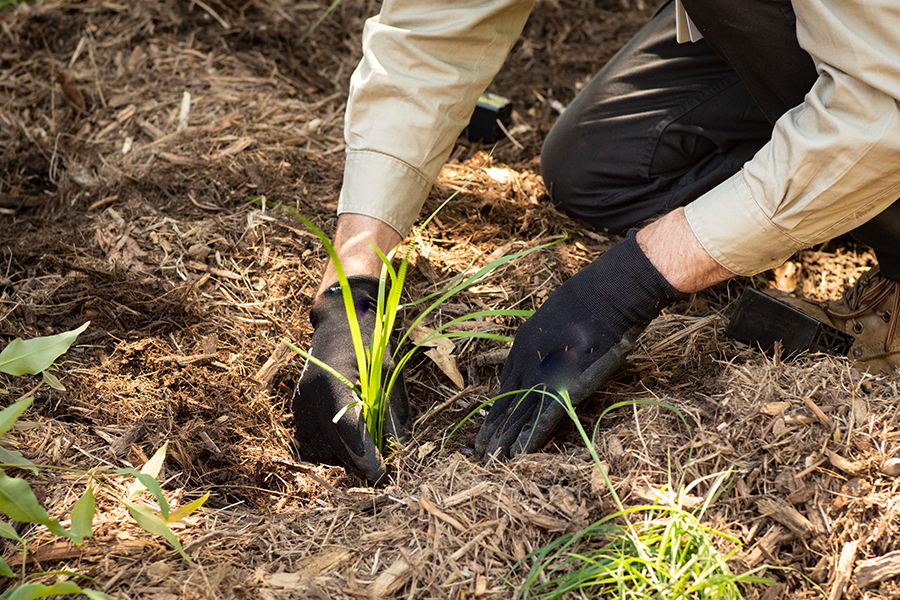Bush regeneration: Build on existing foundations

In the 1970s, Joan and Eileen Bradley established the widely accepted principles of bush regeneration, now known as the Bradley Method of Bush Regeneration. Born into a family of scientists and armed with perseverance and a lot of hard work, they developed these principles through trial and error.
These principles still form much of the basis of modern bush regeneration, which is now often termed minimal disturbance bush regeneration or assisted natural regeneration. However, approaches have changed since their initial work with developments in defining terms and approaches to work with the broader practices of ecological restoration.
Suppose you're lucky enough to have existing areas of native vegetation present. In that case, there's a good chance this will provide a seed bank for the natural regeneration of plants native to the area.
Having existing native vegetation is excellent. It provides you with a solid foundation to get started. It means your efforts on tree planting will be assisted by natural processes right from the word go. There is likely even regeneration potential hidden in dormant in-situ propagules, or from nearby sources. A skilled assessment of the site will help you find this potential.

Image: Planting tube stock as part of a bush regeneration project.
Principles of regeneration
The National Standards for the Practice of Ecological Restoration outline four approaches to ecological restoration inputs, dependent upon the site’s level of resilience (capacity to recover naturally) and colonisation potential.
Beginning with spontaneous regeneration (where the area is able to recover unaided after cessation of damaging activities) and moving right through to a reconstruction of the site, assisted natural regeneration is required when a spontaneous regeneration isn’t achievable, and some help is required.
Broadly speaking, the goal of assisted natural regeneration is to encourage as healthy as possible an area of bushland and to allow that to extend outwards into new areas. The three principles of regeneration are as follows:
- Start in the area with the least weed presence. This area has the most chance of having a seed bank for natural regeneration.
- Disturb the soil as little as possible. Using low impact methods keeps the off-target damage to a minimum and encourages natural regeneration.
- Don't over clear the site. Let the rate of regeneration guide the rate of weed removal. If you clear too large an area without having a native seed bank to regenerate, it will simply allow new varieties of weeds to grow.
Helpful methods for use in bush regeneration
- Hand removal: including crowning and removal of corms, bulbs and tubers
Stem scraping: for vines and scrambling plants - Stem wiping: for weeds with multiple underground cormlets or bulblets, or those growing through desirable vegetation
- Cut and swab: for small to medium-sized woody weeds
- Drill and fill: for larger woody weeds (also called stem injection or frill and fill)
- Cool burns
Here's an excellent resource for each of the above methods: Weed removal fact sheets for bush regenerators
Two other methods not as commonly used in a bush regeneration context due to the increased chance of off-target damage, but at times can be more appropriate if used with care, include:
- Basal bark: for small and large woody weeds
- Spot spraying: for many groups of weeds
Video: The Dabber Herbicide Applicator used in cut and swab herbicide applications - watch the video
Next steps
Natural regeneration isn't possible in many cases because of extensive site degradation, and as a result, there isn't a native seed bank present to allow it to occur.
In these situations, the site requires a reconstructive revegetation approach, where the site is rebuilt from the ground up. However, if the native vegetation exists, it presents a foundation worth building on.
Our next blog installment will focus on planning a reconstructive revegetation project for highly degraded sites.
If you have any questions relating to the natural regeneration of your site, feel free to reach out to our team. Please email us at info@arborgreen.com.au.
If you've recently completed a noteworthy tree planting or bush revegetation project and you would like to feature your planting project, follow this link to fill in your project details.
Access the full Revegetation blog series.
Header image credit: The Natural Trust (NSW)
/Arborgreen%20-%20DGreen%20-%20RGB%20-%20Sml.png?width=1045&height=347&name=Arborgreen%20-%20DGreen%20-%20RGB%20-%20Sml.png)

